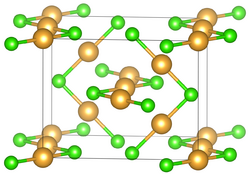Chemistry:Gold(I) chloride

| |
| Names | |
|---|---|
| IUPAC name
Gold(I) chloride
| |
| Other names
Aurous chloride
| |
| Identifiers | |
3D model (JSmol)
|
|
| ChEBI | |
| ChemSpider | |
PubChem CID
|
|
| UNII | |
| |
| |
| Properties | |
| AuCl | |
| Molar mass | 232.423 g/mol |
| Appearance | yellow solid |
| Density | 7.6 g/cm3 [1] |
| Melting point | 170 °C (338 °F; 443 K) |
| Boiling point | 298 °C (568 °F; 571 K) (decomposes) |
| very slightly soluble | |
| Solubility | soluble in HCl, HBr organic solvents |
| −67.0·10−6 cm3/mol | |
| Structure | |
| Tetragonal, tI16 | |
| I41/amd, No. 141 | |
| Hazards | |
| Safety data sheet | MSDS |
| NFPA 704 (fire diamond) | |
Except where otherwise noted, data are given for materials in their standard state (at 25 °C [77 °F], 100 kPa). | |
| Infobox references | |
Gold(I) chloride is a compound of gold and chlorine with the chemical formula AuCl.
Preparation
Gold(I) chloride is prepared by thermal decomposition of gold(III) chloride.
Reactions
Although there is a region of stability at higher temperatures at the appropriate chlorine vapor pressures, the compound is metastable at ambient conditions. When heated with water, the compound dispropotionates to metallic gold and gold(III) chloride in an autoredox reaction:
- 3 AuCl → 2 Au + AuCl3
At still higher temperatures, around 500 °C, all gold chlorides convert to gold. This conversion is key to the Miller process, which is widely used for the purification of gold.[2]
Reaction with potassium bromide yields potassium auric bromide and potassium chloride with separation of metallic gold:
- 3 AuCl + 4 KBr → KAuBr4 + 2 Au + 3 KCl
Safety
Gold(I) chloride may irritate the skin and eyes, damage kidney function, and reduce white blood cell counts.
References
- ↑ Pradyot Patnaik. Handbook of Inorganic Chemicals. McGraw-Hill, 2002, ISBN:0-07-049439-8
- ↑ Renner, Hermann; Schlamp, Günther; Hollmann, Dieter; Lüschow, Hans Martin; Tews, Peter; Rothaut, Josef; Dermann, Klaus; Knödler, Alfons et al. (2000). "Gold, Gold Alloys, and Gold Compounds". Ullmann's Encyclopedia of Industrial Chemistry. doi:10.1002/14356007.a12_499. ISBN 3527306730.
 |


